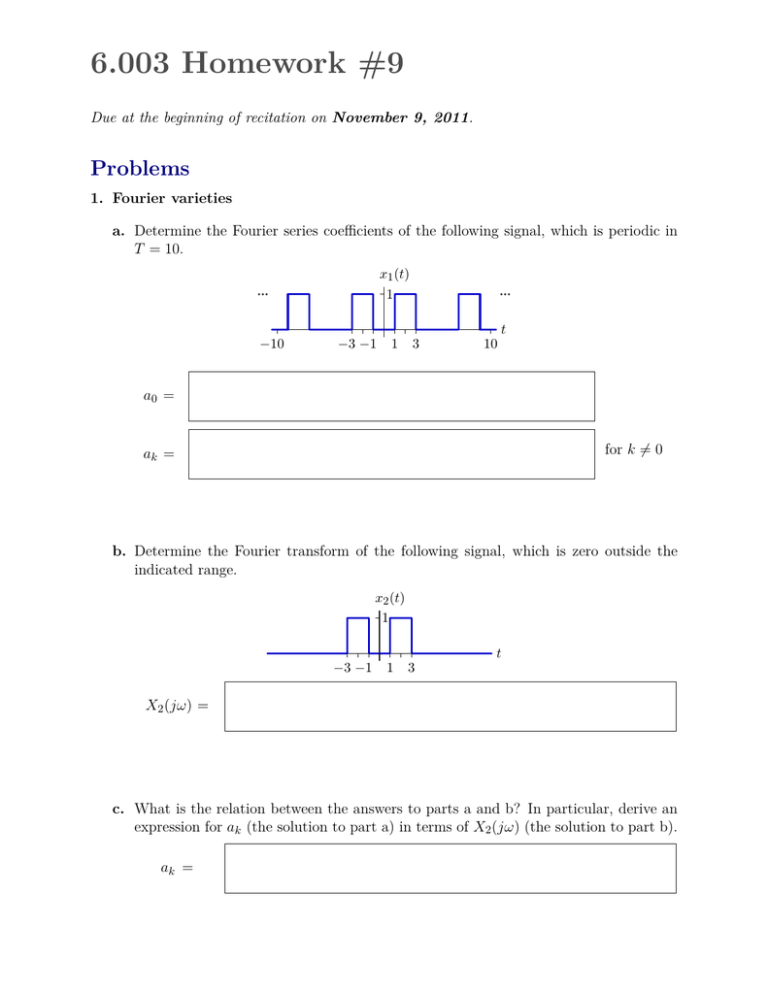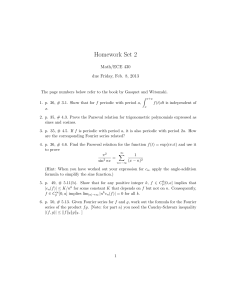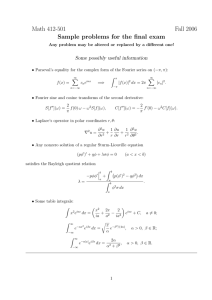6.003 Problems Due T
advertisement

6.003 Homework #9 Due at the beginning of recitation on November 9, 2011. Problems 1. Fourier varieties a. Determine the Fourier series coefficients of the following signal, which is periodic in T = 10. x1 (t) 1 t −10 −3 −1 1 3 10 a0 = for k = 0 ak = b. Determine the Fourier transform of the following signal, which is zero outside the indicated range. x2 (t) 1 t −3 −1 1 3 X2 (jω) = c. What is the relation between the answers to parts a and b? In particular, derive an expression for ak (the solution to part a) in terms of X2 (jω) (the solution to part b). ak = 6.003 Homework #9 / Fall 2011 2 d. Determine the time waveform that corresponds to the following Fourier transform, which is zero outside the indicated range. X3 (jω) 1 ω −3 −1 1 3 x3 (t) = e. What is the relation between the answers to parts b and d? In particular, derive an expression for x3 (t) (the solution to part d) in terms of X2 (jω) (the solution to part b). x3 (t) = 6.003 Homework #9 / Fall 2011 3 2. Fourier transform properties Let X(jω) represent the Fourier transform of x(t) = e−t 0 0<t<1 . otherwise Express the Fourier Transforms of each of the following signals in terms of X(jω). x1 (t) 1 t 1 X1 (jω) = x2 (t) 1 t 1 −1 X2 (jω) = x3 (t) 1 t 1 X3 (jω) = 6.003 Homework #9 / Fall 2011 3. Fourier transforms Find the Fourier transforms of the following signals. a. x1 (t) = e−|t| cos(2t) X1 (jω) = b. x2 (t) = sin(2πt) π(t − 1) X2 (jω) = 4 6.003 Homework #9 / Fall 2011 2 c. x3 (t) = t 0 < t < 1 0 otherwise X3 (jω) = d. x4 (t) = (1 − |t|) u(t + 1)u(1 − t) X4 (jω) = 5 6.003 Homework #9 / Fall 2011 6 Engineering Design Problem 4. Parseval’s theorem Parseval’s theorem relates time- and frequency-domain methods for calculating the av­ erage energy of a signal as follows: ∞ 0 1 |ak |2 |x(t)|2 dt = T T k=−∞ where ak represents the Fourier series coefficients of the periodic signal x(t) with period T. a. We can derive Parseval’s theorem from the properties of CT Fourier series. 1. Let y(t) = |x(t)|2 . Find the Fourier series coefficients bk of y(t). [Hint: |x(t)|2 = x(t)x∗ (t).] 2. Use the result from the previous part to derive Parseval’s theorem. b. Let x1 (t) represent the input to an LTI system, where ∞ 0 x1 (t) = π α|k| e jk 4 t k=−∞ for 0 < α < 1. The frequency response of the system is H(jω) = 1 |ω| < W 0 otherwise. What is the minimum value of W so that the average energy in the output signal will be at least 90% of that in the input signal. 6.003 Homework #9 / Fall 2011 7 5. Filtering The point of this question is to understand how the magnitude of a filter affects the output and how the angle of a filter affects the output. Consider the following RC circuit as a “filter.” R + vi + − vo C − Assume that the input vi (t) is the following square wave. vi (t) 1 2 0 − 21 t T If the fundamental frequency of the square wave ( 2π T ) is equal to the cutoff frequency of 1 the RC circuit ( RC ) then the output vo (t) will have the following form. vo (t) 1 2 0 − 12 t T We can think of the RC circuit as “filtering” the square wave as shown below. |H(jω)| 1 0.1 ∠H(jω)| 0.01 0.01 0.1 1 10 ω 100 1/RC 10 ω 100 1/RC 0 − π2 0.01 0.1 1 The RC filter has two effects: (1) The amplitudes of the Fourier components of the input (vertical red lines in upper panel) are multiplied by the magnitude of the frequency response (|H(jω)|). (2) The phase of the Fourier components (red dots in lower panel) are shifted by the phase of the frequency response (∠H(jω)). a. Determine (using whatever method you find convenient) the output that would result if vi (t) were passed through a filter whose magnitude is |H(jω)| (as above) but whose phase function is 0 for all frequencies. Compare the result with vo (t) above. 6.003 Homework #9 / Fall 2011 8 b. Determine (using whatever method you find convenient) the output that would result if vi (t) were passed through a filter whose phase function is ∠H(jω) (as above) but whose magnitude function is 1 for all frequencies. Compare the result with vo (t) above. MIT OpenCourseWare http://ocw.mit.edu 6.003 Signals and Systems Fall 2011 For information about citing these materials or our Terms of Use, visit: http://ocw.mit.edu/terms.






